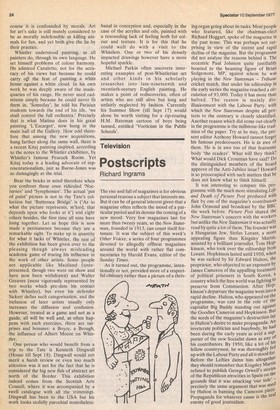Art
Lifetime
by John McEwen
'Whistler and his Influence in Brtain' (Tate Gallery till Oct 30) could hardly have come at a more appropriate moment. It commemorates the centenary of the legendary court case in which Whistler accused Ruskin of libel for declaring that one of his `Nocturnes' was nothing more than a pot of paint flung in the public's face. Recently Fyfe Robertson tn television and J.W. Lambert in the press, their philistine convictions no doubt encouraged by the success of Tom Wolfe's 'The Painted Word', have attacked non-representational tendencies in art in more or less identical terms. What bugged Sir John Holker and Judge Huddleston in 1877 still bugs them this very August: why should anyone be paid for this sort of thing? How long, asked Sir John, did it take to `knock off' one of these 'Nocturnes'? ,„Two days, replied Whistler. 'And that was the labour for which you asked two hundred guineas?' No,' said the artist 'it was for the knowledge gained through a lifetime.'
This mercenary raison d'être means, then as now, that art in England is never taken for granted. It must be justified in business terms. Representational art is acceptable because most people, if only as children, have discovered that they cannot do it as well as 'artists' can. Most of them, in fact, have probably found , they cannot do it at all. They are therefore willing to admit that those who do it have benefited from some superior talent. The talent has been trained, training requires effort, effort deserves money. The Huddlestons and Lamberts of England want to know they are getting their money's worth, in art as in anything else. That is the root of the problem, but of course it is confounded by morals. Art for art's sake is still mutely considered to be as morally indefensible as killing animals for fun, and yet both give the lie by their practice.
Whistler understood painting, as all painters do, through its own language. He set himself problems of colour harmony. He admired Canalett°, not for the accuracy of his views but because he could carry off the feat of painting a white house against a white cloud. In his own work he was deeply aware of the inadequacies of his range. He never used cadmiums simply because he could never fit them in. 'Someday', he told his Parisian students towards the end of his life, 'we shall control the full orchestra.' Precisely that is what Matisse does in his great painting `L'Escargoe, now hung in the main hall of the Gallery. How odd therefore that among the new acquisitions, hung farther along the same wall, there is a recent Kitaj painting inspired, according to the notes to the Whistler exhibition, by Whistler's famous Peacock Room. Yet Kitaj today is a leading advocate of representationalism, just as Burne-Jones was so damagingly at the trial.
Bear the bricks in mind therefore when you confront these once ridiculed 'Nocturnes' and 'Symphonies'. The actual 'pot of paint' picture is not in the Tate's collection but 'Battersea Bridge' is (`As to what the picture represents, mlord, that depends upon who looks at it') and eight others besides, the first time all nine have hung together. Let us hope this is now made a permanence because they are a remarkable sight. To make up in quantity for what it lacks of Whistler, the rest of the exhibition has been given over to the pleasing though always misleading academic game of tracing his influence in the work of other artists. Some people are applicable like Maitland (unrepresented, though two were on show and have now been withdrawn) and Walter Greaves (most vigorously represented by two works which pre-date his contact with Whistler), but even his defender Sickert defies such categorisation, and the inclusion of later artists usually only increases the diffusion and confusion. However, treated as a game and not as a guide, all will be well and, as often happens with such exercises, there are surprises and bonuses: a Boyce, a Brough, the influence of Albert Moore on Whistler.
One person who would benefit from a trip to the Tate is Kenneth Dingwall (House till Sept 18). Dingwall would not merit a harsh review or even too much attention was it not for the fact that he is considered the big new fish of abstract art north of the Border. This exhibition indeed comes from the Scottish Arts Council, where it was accompanied by a swell catalogue with all the trimmings. Dingwall has been to the USA but his work looks stolidly parochial nonetheless: banal in conception and, especially in the case of the acrylics and oils, painted with a resounding lack of feeling both for colour and texture. It is for this that he could well do with a visit to the Whistlers. One or two of his densely impacted drawings however have a more hopeful sparkle.
Michael Parkin often uncovers interesting examples of post-Whistlerian art and other • kinds in his scholarly researches into late-nineteenth and twentieth-century English painting. He makes a point of rediscoveries, often of artists who are still alive but long and unfairly neglected by fashion. Currently his Summer Show (till Sept 17) would alone be worth visiting for a rip-roaring H.M. Bateman cartoon of boys being tanned, entitled ‘Vorticism in the Public Schools'.































 Previous page
Previous page